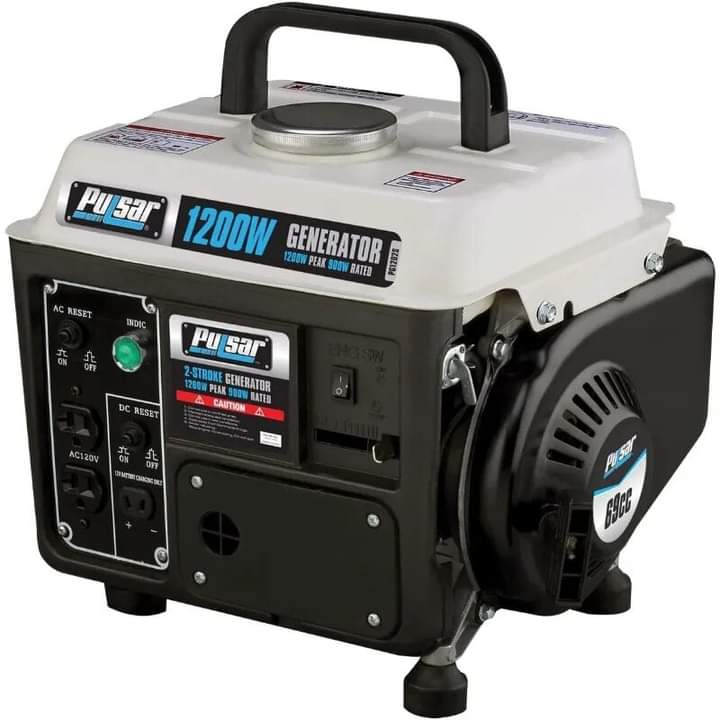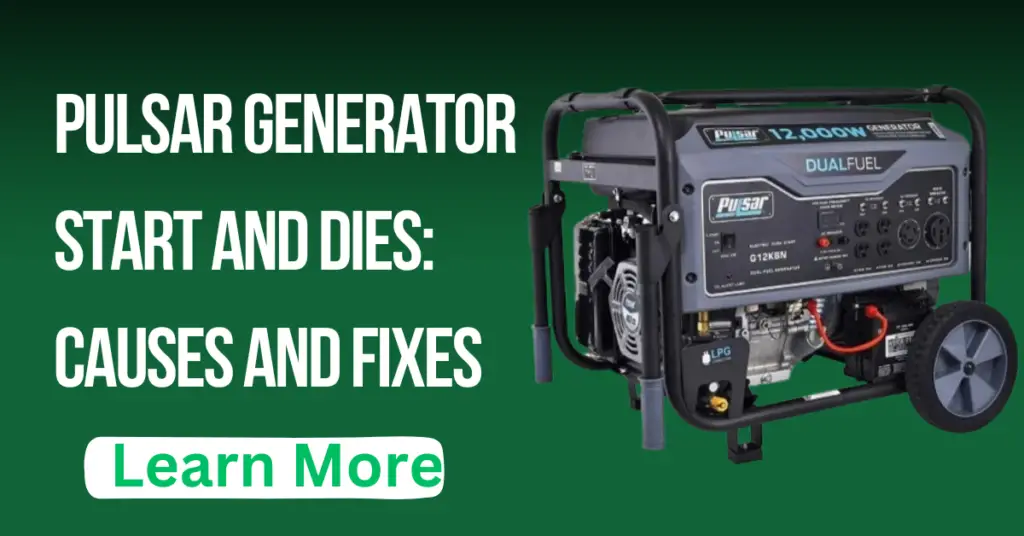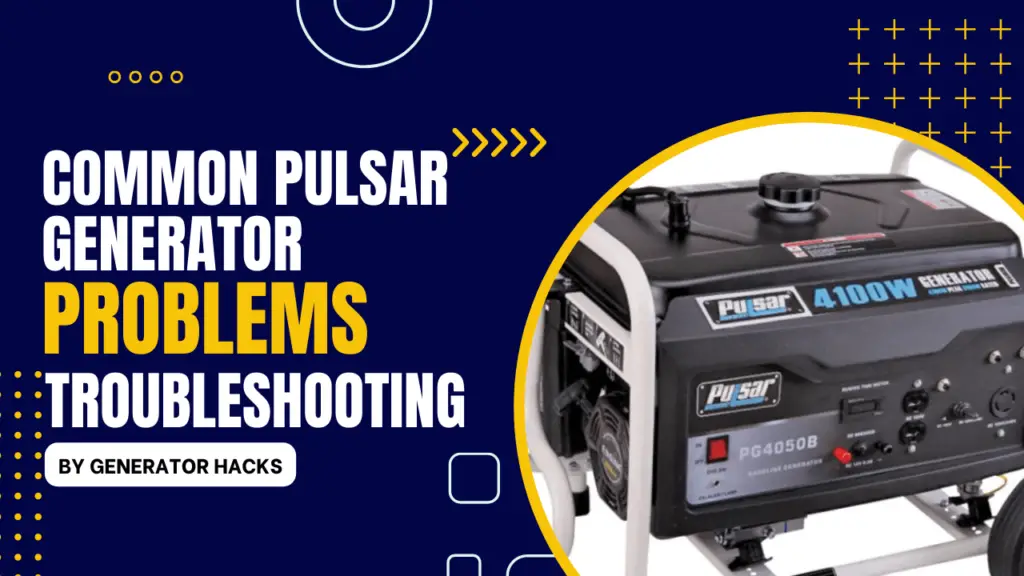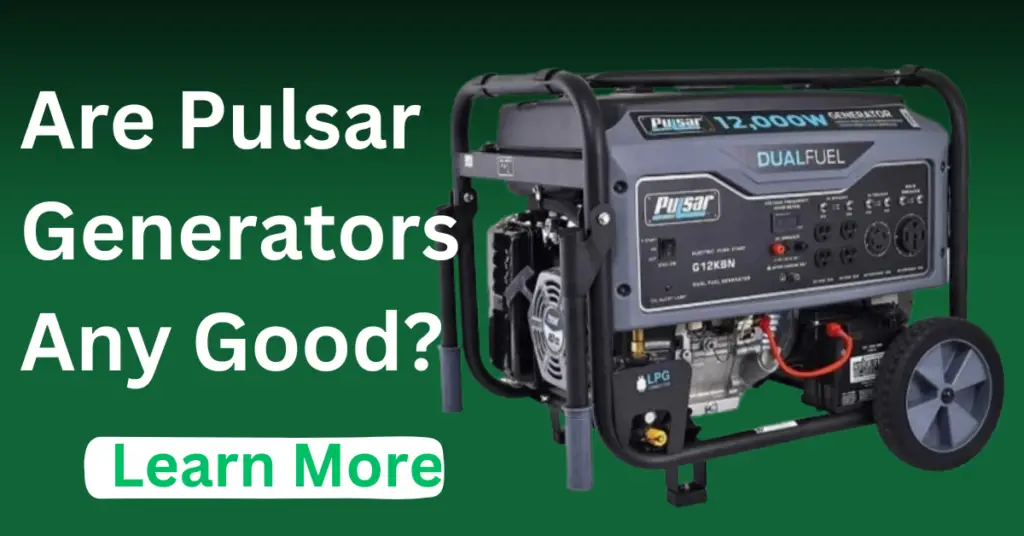As an Amazon Associate, we earn from qualifying purchases. This does not affect the price you pay or the quality of the products you buy. For more information, please read the full affiliate disclosure here.
Imagine this scenario: you are in the middle of a power outage, and you need to use your Pulsar generator to run your essential appliances. You have prepared enough fuel, oil, and extension cords, and you are ready to start your generator. But when you press the electric start button or pull the recoil starter, nothing happens. Your generator won’t start, and you don’t know why. What do you do?
Don’t panic. This is a common problem that many Pulsar generator owners face, and it can be caused by a variety of reasons. Some of them are simple and easy to fix, while others may require more skills and tools. But with some basic knowledge and troubleshooting skills, you can identify and solve most of these problems yourself, and get your generator back to working order.
However, if you have tried all the possible solutions and your Pulsar generator still won’t start, you may have a defective or damaged unit. In that case, you should check the warranty status of your generator and contact the Pulsar customer service for assistance.
But, if your warranty has expired, you can read till the end of this article. In this article, we will show you how to troubleshoot and fix a Pulsar generator that won’t start, by explaining some of the common causes and solutions.
Let’s get started!
Common Reasons And Solutions Why Your Pulsar Generator Won’t Start

Problem 1. Empty or Bad Fuel
One of the simplest and most common reasons why a Pulsar generator won’t start is that it has no fuel or bad fuel in the tank.
If you have not used your generator for a long time, the fuel may have degraded or evaporated, leaving behind water, dirt, or varnish that can clog the fuel system and damage the engine.
Alternatively, if you have recently refilled your generator with fresh fuel, you may have used the wrong type or quality of fuel.
Pulsar generators with 2-cycle engines require a mixture of gas and oil at a 30:1 ratio, while generators with 4-cycle engines use straight gas and have a separate tank for engine oil.
Solution
Check the fuel level and quality of your generator. If the tank is empty, fill it with fresh fuel of the correct type and grade. If the fuel is old or contaminated, drain the tank and replace it with new fuel. You can also add a fuel stabilizer or cleaner to prevent the fuel from breaking down or clogging the system.
Also Read:- Common Pulsar Generator Problems: How to Diagnose and Fix Them
Problem 2. Clogged or Dirty Fuel System
Another common reason why a Pulsar generator won’t start is that the fuel system is clogged or dirty. This can happen due to the use of bad fuel, or the accumulation of dust, debris, or corrosion over time.
The fuel system consists of several components, such as the fuel filter, the fuel line, the carburetor, and the fuel tank vent.
Any of these parts can become blocked or malfunctioning, preventing the fuel from reaching the engine or creating a vacuum in the tank.
Solution
Inspect the fuel system and clean or replace any parts that are dirty or damaged.
The fuel filter is usually located near the fuel tank or the carburetor and can be easily removed and cleaned or replaced.
The fuel line is a rubber hose that connects the tank to the carburetor and can be checked for cracks, leaks, or clogs.
The carburetor is a metal device that mixes the fuel and air for combustion and can be cleaned with a carburetor cleaner spray or a brush.
The fuel tank vent is a small hole or valve on the fuel cap or the top of the tank and can be cleared with a needle or a wire.
Also Read:- Pulsar Generator Start and Dies: Causes and Fixes
Problem 3. Faulty or Dirty Spark System
The spark system is responsible for igniting the fuel and air mixture in the engine. It consists of the spark plug, the spark plug wire, and the ignition coil. If any of these parts are faulty or dirty, the spark system will fail to produce a strong and consistent spark, and the engine will not start. Some of the signs of a faulty or dirty spark system are a wet or blackened spark plug, a loose or corroded spark plug wire, or a cracked or burned ignition coil.
Solution
Check the spark system and clean or replace any parts that are faulty or dirty.
The spark plug is usually located on the side or the top of the engine, and can be easily removed and cleaned or replaced.
The spark plug wire is a thick cable that connects the spark plug to the ignition coil and can be checked for damage or corrosion.
The ignition coil is a small device that generates the high voltage for the spark and can be tested with a multimeter or a spark tester.
Problem 4. Incorrect or Low Engine Oil
Some Pulsar generators have a low oil sensor that shuts off the engine automatically when the oil level is too low or the oil pressure is too high.
This is a safety feature that protects the engine from overheating or seizing. However, if the oil level is incorrect or the oil is dirty or degraded, the sensor may malfunction and prevent the engine from starting.
Alternatively, if the oil level is correct but the oil is too thick or too thin, the engine may not run smoothly or efficiently.
Solution
Check the oil level and quality of your generator. If the oil level is too low, add more oil of the correct type and grade. If the oil level is too high, drain some oil until it reaches the proper level.
If the oil is dirty or degraded, change the oil and the oil filter. You can also check the oil sensor and the oil switch for damage or malfunction, and replace them if necessary.
Also Read:- Generator Shuts Off After 20 Minutes: Troubleshooting Tips
Problem 5. Damaged or Loose Recoil Starter
The recoil starter is a device that allows you to manually start the engine by pulling a cord. It consists of a spring, a pulley, a rope, and a handle. If any of these parts are damaged or loose, the recoil starter will fail to engage the flywheel and turn the engine over, preventing it from starting. Some of the signs of a damaged or loose recoil starter are a broken or frayed rope, a loose or missing handle, or a jammed or noisy pulley.
Solution
Check the recoil starter and repair or replace any parts that are damaged or loose.
The recoil starter is usually located on the side or the top of the engine, and can be easily removed and repaired or replaced.
You can use a screwdriver, a wrench, or a plier to fix the recoil starter or replace it with a new one if it is beyond repair.
Problem 6. Faulty or Dirty Spark Arrestor
The spark arrestor is a device that prevents sparks from escaping the exhaust and causing fires. It is up a metal screen or a mesh that covers the end of the muffler.
If the spark arrestor is faulty or dirty, it will reduce the exhaust flow and create back pressure, affecting the engine’s performance or causing it to stall or not start.
Some of the signs of a faulty or dirty spark arrestor are a loud or rattling exhaust, a loss of power, or a hard start.
Solution
Check the spark arrestor and clean or replace it if it is faulty or dirty. The spark arrestor is usually located on the end of the muffler and can be easily removed and cleaned or replaced.
You can use a wire brush, a scraper, or a torch to clean the spark arrestor or replace it with a new one if it is damaged or worn out.
Also Read: How to Clean Spark Arrestor Without Blowtorch: A Simple Guide
Problem 7. Damaged or Worn Out Engine Parts
The engine is the heart of your generator, and it consists of many parts that work together to produce power. However, over time, some of these parts may get damaged or worn out due to normal wear and tear, improper maintenance, or overheating.
Some of the parts that may affect the engine’s ability to start or run properly are the piston, the cylinder, the valves, the rings, the head gasket, and the crankshaft.
If any of these parts are damaged or worn out, they will cause compression loss, oil leakage, or mechanical failure, resulting in poor performance or no start.
Solution
Check the engine parts and repair or replace them if they are damaged or worn out. The engine parts are usually located inside the engine block and can be accessed by removing the engine cover and the cylinder head.
You can use a compression tester, a leak-down tester, or a visual inspection to check the engine parts or consult a professional technician for diagnosis and repair. You can also replace the entire engine if it is beyond repair.
Problem 8. Faulty or Dead Battery
Some Pulsar generators have an electric start feature that allows you to start the engine with a push of a button. This feature requires a battery that provides the power to the starter motor.
If the battery is faulty or dead, the electric start feature will not work, and you will have to use the recoil starter instead.
Some of the signs of a faulty or dead battery are a weak or no cranking sound, dim or no lights, or a low or no voltage reading.
Solution
Check the battery and charge or replace it if it is faulty or dead. The battery is usually located in a plastic or metal box near the engine and can be easily removed charged or replaced. You can use a voltmeter, a battery charger, or a jump starter to check and charge the battery or replace it with a new one if it is damaged or worn out.
Problem 9. Damaged or Loose Wiring
The wiring is the system of wires and connectors that carries the electrical current from the battery to the starter, the ignition, and the other electrical components of the generator.
If the wiring is damaged or loose, it will cause a short circuit, a poor connection, or a voltage drop, affecting the electrical system and preventing the engine from starting or running properly.
Some of the signs of damaged or loose wiring are sparks, smoke, melted or burned wires, or loose or corroded connectors.
Solution
Check the wiring and repair or replace any parts that are damaged or loose. The wiring is usually located under the engine cover or the control panel and can be accessed by removing the screws or bolts.
You can use a wire stripper, a soldering iron, or a crimping tool to repair the wiring or replace it with a new one if it is beyond repair.
You can also use a multimeter, a continuity tester, or a wiring diagram to check the wiring for faults or breaks.
Problem 10. Faulty or Damaged Starter Motor or Solenoid
The starter motor is a device that spins the engine over when you press the electric start button. The solenoid is a device that connects the battery to the starter motor when you turn the key or the switch.
If the starter motor or the solenoid is faulty or damaged, the electric start feature will not work, and you will have to use the recoil starter instead.
Some of the signs of a faulty or damaged starter motor or solenoid are a clicking or grinding sound, a slow or no cranking, a blown fuse, or a tripped breaker.
Solution
Check the starter motor and the solenoid and repair or replace them if they are faulty or damaged. The starter motor and the solenoid are usually located near the engine and can be easily removed and repaired or replaced.
You can use a screwdriver, a wrench, or a plier to fix the starter motor and the solenoid or replace them with new ones if they are beyond repair.
You can also use a multimeter, a jumper wire, or a starter tester to check the starter motor and the solenoid for faults or breaks.
Problem 11. Faulty or Damaged Control Panels or Switches
The control panel is the device that allows you to control the functions and features of your generator. It consists of various switches, buttons, indicators, and outlets.
If the control panel or any of its components is faulty or damaged, it will affect the operation and performance of your generator and may prevent it from starting or running properly.
Some of the signs of a faulty or damaged control panel or switch are a broken or loose switch, a burned or melted component, or a dead or flickering indicator.
Solution
Check the control panel and its components and repair or replace them if they are faulty or damaged. The control panel is usually located on the side or the front of the generator and can be accessed by removing the screws or bolts.
You can use a screwdriver, a soldering iron, or a crimping tool to repair the control panel and its components or replace them with new ones if they are beyond repair.
You can also use a multimeter, a continuity tester, or a wiring diagram to check the control panel and its components for faults or breaks.
Also Read: Are Pulsar Generators Any Good?
Final Words
These are some of the common reasons why a Pulsar generator won’t start, and how to fix them. However, there may be other factors that affect the performance of your generator. But if you have tried the solutions above and your generator still won’t start, you may need to consult a professional technician or contact Pulsar customer service for further assistance.




